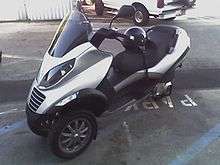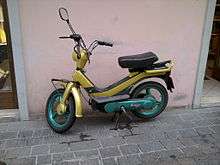Piaggio
 | |
| Public | |
| Traded as | BIT: PIA |
| Industry |
|
| Founded | Sestri Ponente, Italy (January 24, 1884) |
| Founder | Rinaldo Piaggio |
| Headquarters | Pontedera, Italy |
Area served | Worldwide |
Key people |
|
| Revenue |
|
|
| |
| Profit |
|
Number of employees | 7,510 (2014)[2] |
| Subsidiaries |
|
| Website |
piaggiogroup |
Piaggio & C. SpA (Piaggio) [ˈpjaddʒo] via its subsidiaries designs, engineers, manufactures and distributes two wheeled motor vehicles and compact commercial vehicles under seven brands. Piaggio & C. SpA corporate headquarters are located in Pontedera, Italy. Piaggio's various subsidiaries employ a total of 7,053 employees who produced a total of 519,700 vehicles in 2014.[3] Piaggio operates six research and development centers and operates in over 50 countries.[4]
History
Founded by Rinaldo Piaggio in 1884, Piaggio initially produced locomotives and railway carriages. During World War I the company focused on producing aircraft.
During World War II the company produced bomber aircraft, but Piaggio emerged from the conflict with its Pontedera plant completely demolished by Allied bombing. Italy's crippled economy and the disastrous state of the roads did not assist in the redevelopment of the automobile markets. Enrico Piaggio, the son of Piaggio's founder Rinaldo Piaggio, decided to leave the aeronautical field in order to address Italy's urgent need for a modern and affordable mode of transportation. The idea was to design an inexpensive vehicle for the masses.
Aeronautical engineer Corradino D'Ascanio, responsible for the design and construction of the first modern helicopter by Agusta, was asked by Enrico Piaggio to create a simple, robust and affordable vehicle. The vehicle had to be easy to drive for both men and women, be able to carry a passenger, and not get its driver's clothes dirty. In 1946 Piaggio launched the Vespa scooter (Italian for "wasp") and within ten years over a million units had been produced. The Italian language gained a new word, "vespare", meaning to go somewhere on a Vespa.
Development
With strong cash flow from the success of the Vespa, Piaggio developed other products, including the 1957 Vespa 400, a tiny passenger car.
In 1959, Piaggio came under the control of the Agnelli family, the owners of car maker Fiat SpA. In 1964 the two divisions, aeronautical and motorcycle, split to become two independent companies as a result of the wide ownership by Fiat in Italian industry. The aeronautical division was named IAM Rinaldo Piaggio. The aircraft company Piaggio Aero is controlled by the family of Piero Ferrari, who still hold 10% of Ferrari.
In 1969 Piaggio purchased the motorcycle company Gilera.
Under new ownership
Vespa thrived, until 1992, when Gianni Agnelli became CEO, but Agnelli was already suffering from cancer and died in 1997. In 1999 Morgan Grenfell Private Equity acquired Piaggio, but hopes for a quick sale were dashed by a failed joint venture in China. In Italy, Piaggio invested 15 million euros ($19.4 million) in a new motorcycle but dropped it after building a prototype. By the end of 2002, the company had run up 577 million Euros in debt on revenues of 945 million Euros, and booked a loss of 129 million Euros.
Then came Roberto Colaninno, who said, "A lot of people told me I was crazy. Piaggio wasn't dying. It just needed to be treated better." Piaggio's financial position was in a bad shape, but its brand was still well known and its products were featured in many Hollywood films thanks to the Vespa ET4. In 1995, Colaninno had pulled off Europe's then largest-ever hostile takeover when he took control of Telecom Italia SpA. In September 2003, Piaggio's debt was reduced by the 100 million Euro cash investment made by Colaninno through his holding company Immsi SpA. There was also 150 million shares converted by creditor banks. Roberto Colaninio becomes the new chairman of Piaggio with Dr. Rocco Sabelli becoming the managing director. Dr. Rocco Sabelli redesigned the factory on Japanese principles, and changed it so that every Piaggio scooter could be made on any assembly line.
Unlike the turnaround recipe applied at U.S. auto makers, Mr. Colaninno did not fire a single worker – a move which helped seduce the company's sceptical unions. "Everyone in a company is part of the value chain," said Colaninno. All bonuses for blue-collar workers and management were based on the same criteria: profit margins and customer satisfaction. Air conditioning was installed in the factory for the first time, increasing productivity. He also gave the company's engineers, who had been idled by the company's financial crisis, deadlines for projects. They rolled out two world firsts in 2004: a gas-electric hybrid scooter and a sophisticated tilting scooter with two wheels in front and one in back to grip the road better.
One of Piaggio's problems Mr. Colaninno couldn't fix from the inside was its scale. Even though Piaggio was the European market leader, it was dwarfed by rivals Honda and Yamaha. A year after restoring Piaggio's health, Colaninno directed Piaggio's takeover of the Italian scooter and motorcycle manufacturer Aprilia, and with it the Aprilia-owned Moto Guzzi, storied Italian manufacturer of motorcycles.
In 2006, Piaggio floated on the Milan Stock Exchange, becoming a public company.
"Cultural Project" Piaggio
The "cultural project" promoted by Piaggio is aimed for the reconstruction and enhancement of the company's heritage and is composed by three initiatives: Piaggio Foundation, Historical Archives and the Piaggio Museum. In 2003 the Museum and Archives have been recognized as Best Corporate Museum and Archives for the Italian prize "Premio Impresa e Cultura".[5]
Brands and models


Group brands
- Aprilia - motorcycles, scooter and mopeds
- Piaggio - scooters, mopeds
- Vespa - scooters and mopeds
- Scarabeo - scooters and mopeds
- Derbi - motorcycles, scooters, mopeds and recreational ATVs (quads)
- Gilera - motorcycles, scooters, mopeds and recreational ATVs (quads)
- Moto Guzzi - motorcycles
- Piaggio Commercial Vehicles - commercial vehicles
Models

- Piaggio 110 Bicycle bodywork(110 anniversaries)
- Ape - 3-wheel micro light commercial vehicles
- Piaggio Porter 4-wheel microvans and micro-pickups, same as a Daihatsu Hijet.
- Piaggio MP3 tilting 3-wheel scooter
- Diesis 50/100 (50cc air-cooled two-stroke and 100cc water-cooled two-stroke) made between 2001 and 2005
- FLY50/100/125/150
- Free50
- Typhoon 50 cc, 80cc, 125 cc (1995–2000;2012)
- Sfera NSL (50 cc & 80 cc) 1991-1995
- Sfera RST (RST standing for Restyle) (50 cc 2-Stroke & 125 cc 4-Stroke) 1995 - ??
- NRG mc1-3 (50 cc) (mc standing for mark.)
- NRG Power PureJet (50 cc fuel injection, water cooling)
- NRG Power DT (air-cooled) and DD (liquid-cooled), both introduced in 2005
- NTT (water-cooled two-stroke) made between 1995 and 1998
- Liberty (50 cc two-stroke, 125 cc & 150 cc Quattrotempi)
- Liberty S (50 cc 125 cc 200 cc)
- Skipper ST (125 cc)
- Piaggio Ciao (50 cc)
- Si (50 cc)
- Superbravo (50 cc)
- Avanti (50 cc)
- Grillo (50 cc)
- Bravo (50 cc)
- Grande (50 cc)
- Boxer (50 cc)
- Boxer 2 (50 cc)
- X7 125 (European market), 250
- X7 Evo (125, 300 cc) - announced 2009
- X8 125 (European market), 250, 400
- XEvo 125, 250, 400
- X9 125/250 cc Evolution - the Evolution models superseded the previous X9 models in 2004, which were fitted with Honda engines
- X9 500 cc Evolution with features not fitted on 125/250 cc models: hydraulic centre stand, integrated rider-to-pillion communication system, mobile phone charger in front dash cubbyhole
- BV200/250
- BV350
- BV500 - neo-classic style, automatic transmission, top-speed 100 mph
- Beverly (125 cc; 250 cc; 400 cc; 500 cc: Beverly is the Italian name for the BV models)
- Medley 125cc, Medley S 125cc
- Carnaby (125 cc & 200 cc)
- Free 50 (50 cc)
- Hexagon (125 cc; 150 cc; 180 cc; 250 cc)
- T (125 cc; 150 cc)
- Piaggio Velofax or Vespino 1995 to 1999.
- Quartz (50 cc two-stroke, liquid-cooled)
- Quartz (125 cc, two-stroke, air-cooled)
- Storm (125 cc, four-stroke, air-cooled)
- M500 (505 cc, two-stroke, microcar)
- Ravi Piaggio Strom (125 cc, four-stroke) Joint venture of Piaggio with Ravi and available in Pakistani market
- Piaggio Ape RR
- Zip 50 cc two-stroke, air-cooled (pre 2000)
- Zip SP 50 cc two-stroke, water-cooled (pre 2000)
- Zip (Cat) 50 cc two-stroke, air-cooled (2000 onwards)
- Zip SP 50 cc two-stroke, water-cooled (2000 onwards)
- Zip 4t 50 cc four-stroke, air-cooled
- Zip 4t 100 96.2 cc four-stroke, air-cooled
- Zip 125 125 cc four-stroke, air-cooled
Electric scooters
The new plug-in hybrid version of the Piaggio MP3 will be equipped with a 125 cc petrol engine and electric motor, which offers about 141 mpg-US (1.67 L/100 km; 169 mpg-imp) and travels 13 miles (21 km) using battery power alone. This machine could be out in 2009.[6]
Piaggio/Vespa are also developing hybrid electric scooters. There are two models in the works, based on the popular Vespa LX 50 and the beefier Piaggio X8 125.[7]
References
- 1 2 3 , 2015-26-05
- ↑ , 2015-02-27
- ↑
- ↑ Annual Report 2012 - Piaggio Group
- ↑
- ↑ "Piaggio Scooters Gone Green: 141 MPG Hybrid". TreeHugger. Retrieved 2009-08-10.
- ↑ "Vespa Unveils Hybrid Scooters". TreeHugger. Retrieved 2009-08-10.
External links
| Wikimedia Commons has media related to Piaggio vehicles. |